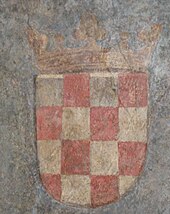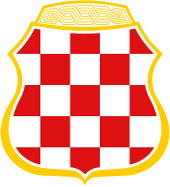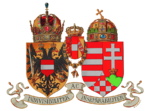Coat of arms of Croatia
| Coat of arms of Croatia | |
|---|---|

|
|
| Details | |
| Authorized to use the coat of arms | Republic of Croatia |
| Introduced | December 22, 1990 |
| Shield shape and division | Half-round shield , nested in 25 fields of red and silver (white) |
| Other elements | Stylized coat of arms crown , consisting of five partial coats of arms |
| Previous versions |
Heraldic shield proven since 1495 |
| use | by government organizations such as B. Armed Forces , Police; on badges and emblems of government organizations, national currency , passport , identity card and official documents (including diplomas); in and on parliament buildings , public buildings, schools |
The coat of arms of the Republic of Croatia ( Croatian Grb Republike Hrvatske ) is the historical Croatian coat of arms, the base of which consists of 25 alternating red and white ( silver ) fields (Article 11 sentence 1 of the Croatian Constitution of December 21, 1990). This slaughtered coat of arms is known colloquially as Šahovnica ( chess board ).
As a secondary part, a stylized five-pointed coat of arms crown is placed on the upper edge of the shield . It consists of the five coats of arms of the most important historical landscapes on the territory of the Republic of Croatia .
The detailed design of the national coat of arms with the use of the coat of arms crown is carried out by the law on the coat of arms, the flag and anthem of the Republic of Croatia, as well as the flag and sash of the President of the Republic of Croatia of December 21, 1990. Part of the law was also a sample drawing of the overall coat of arms which the graphic artist Miroslav Šutej carried out and which was confirmed by a state commission.
In September 2011 the Croatian Parliament established new graphic standards for the execution of the coat of arms of the Republic and the President through sample drawings.
The coat of arms is part of the flag of Croatia .
history
Heraldic shield
Legend has it that the Croatian King Stjepan Držislav († 997), who was captured by the Republic of Venice , won his chess three times against the Venetian Doge Pietro II Orseolo and thus prevented bloodshed. From then on, the checkerboard pattern in the color of blood was to be the coat of arms of the Croats. After another interpretation of the red and white squares of the checkerboard pattern were originally the old province ( Banovine , German: Banats) of Rotkroatien and White Croatia represent - created by the medieval rule of division of the country in continental inland areas (red) and maritime coastal areas (white) which were only united into a common Croatian kingdom under Tomislav in 925 .
In fact, the Croatian coat of arms was not created until around 500 years later. The coat of arms apparently goes back to the initiative of Maximilian I who, after the Peace of Pressburg in 1491, became the titular king of the Kingdom of Hungary and its neighboring countries alongside the reigning King Vladislav II . Very soon after 1491 Maximilian I was likely to have commissioned a coat of arms for the Kingdom of Croatia. This created a typical “ speaking coat of arms ” with squares, alluding to the similar sound of the word square for Croatian .

The oldest surviving depiction of the Croatian coat of arms from 1495 is openly accessible in the arbor vault of the Stadtrichter-Zeller house in the old town of Innsbruck . The ceiling fresco shows the coat of arms of the Kingdom of Croatia, starting with a first silver (white) field and a division into 16 red and white (silver) fields.
Another depiction of the crowned coat of arms can be found in Maximilian I's gate of honor , a monumental woodcut that Emperor Maximilian commissioned from Albrecht Dürer around 1512 to stage his imperial and imperial idea .

In the 19th century Croatia was a country of the Hungarian Crown and therefore also part of Austria-Hungary . The Croatian checkerboard coat of arms was used together with the coat of arms of Dalmatia and Slavonia in a common coat of arms.
In 1940, the checkerboard coat of arms officially became the coat of arms of the autonomous bank of Croatia , founded in 1939 , within the Kingdom of Yugoslavia .
The small coat of arms of the bank showed the historical Croatian coat of arms outlined in gold, beginning with a first red field and crowned with the Serbian or Yugoslav royal crown. It was used e.g. B. for official seals, stamps and postage stamps.
The large coat of arms of the Banschaft showed the Serbian or Royal Yugoslav double-headed eagle with its red beaks, tongues and fangs, crowned with the Yugoslav royal crown and covered with the historical Croatian coat of arms of the small coat of arms. It was used on the oval white nameplates at the entrances to buildings with public offices (e.g. ministries, notaries).
With the establishment of the Independent State of Croatia (the fascist Ustasha State) in 1941, a new state coat of arms was introduced. This consisted of the historical Croatian coat of arms, now starting with a first silver (white) field. In addition, there was a star-shaped ornament made of Croatian wickerwork above the coat of arms . This was formed by three red bands running parallel in the arch (Croatian three-band), which form small loops at the diagonal ends of the resulting octagon. The capital letter U(for Ustasha ) was enclosed by this ornament .
A heraldic shield with a first silver field was probably chosen by the Ustaše to distinguish itself from the coat of arms of the Kingdom of Yugoslavia , which showed a Croatian coat of arms with a first red field. A Croatian coat of arms with a first silver field is still valid today as the "Ustascha coat of arms", although the oldest known depiction in Innsbruck from 1495, the depiction in the Fojnica coat of arms from the 17th century and many old depictions of a first silver field show in the escutcheon.
After the Second World War , the People's Republic of Croatia, the forerunner of the Socialist Republic of Croatia, no longer used the historical coat of arms. Instead, the state symbol from 1945 to 1947 was the red star , framed by a grain of wheat and a branch of laurel.
The coat of arms of the Socialist Republic of Croatia (1947–1990) was framed by grain stalks, the same connected by a star as a symbol of socialism. The Šahovnica (with a first red field) is shown above the sea and has two rounded indentations on the upper side, which create three points. In the background you can see the sun, whose rays run in the cardinal points from west to north to east. Until the corresponding law on flags and coats of arms was passed, the coat of arms was also officially used, starting with the first white field.
The reasons for the use of a first red field in the subsequent versions of the escutcheon are probably also in a parallel to the fascist Croatian Ustasha -State ( " Independent State of Croatia to avoid"), whose coat of arms included a first silver (white) field.
Coat of arms crown
The coat of arms was probably added to the coat of arms in order to make it clear that the Republic of Croatia should only include the areas that are symbolized by the coat of arms depicted in it.
In the crown of the coat of arms the coats of arms of the most important historical landscapes on the territory of the Republic of Croatia are stylized (heraldically) from right to left . These are (mentioned in Section 7 of the Act):

|
The coat of arms of Old Croatia (" Illyrian coat of arms"), the oldest known Croatian coat of arms Blazon : In light blue, a six-pointed golden star over a silver crescent moon . |

|
The coat of arms of Dubrovnik ( Republic of Ragusa ) Blazon: Two horizontal red bars in dark blue . |

|
The coat of arms of Dalmatia ( Kingdom of Dalmatia ) Blazon: Three (two over one) crowned golden leopard heads in light blue . |

|
The coat of arms of Istria Blazon: In dark blue a (heraldic) right-seeing, red-horned and hoofed golden billy goat . |

|
Blazon: In light blue, a six-pointed golden star over a horizontal red bar, accompanied by a narrower silver separation ("Ritterstrasse") at the top and bottom. In the bar a (heraldic) right-handing white-bellied black marten (see also Croatian Kuna ). |
Coat of arms of the President of the Republic of Croatia
In the coat of arms of the President of the Republic of Croatia , introduced in 1990 , the individual coats of arms of the coat of arms crown are arranged around the historical coat of arms.
The coat of arms is carried, among other things, on the presidential standard (Section 23 of the law).
Coat of arms of the Croatians in Bosnia and Herzegovina
The coat of arms of the Croatian Republic of Herceg-Bosna (HR HB) and its predecessor organizations is de facto considered to be the coat of arms of the Croats in Bosnia and Herzegovina . This is a modification of the historical Croatian coat of arms and consists of 25 red and silver boxed fields, starting with a red field. The escutcheon has the shape of a German Renaissance round shield and is made of gold. The Croatian wickerwork is shown in the upper field of the coat of arms . The coat of arms of HR HB can be found for the first time as a cap badge (still surrounded by the halo of the red star cap badge) in the first gendarmerie units of the Republic of Croatia ( Prvi hrvatski redarstvenik ), which were formed in Croatia and the Croatian areas of Bosnia-Herzegovina and from Fall 1990 to the beginning of 1991.
The flag and the coat of arms of the Croatian Republic of Herceg-Bosna are still used today by the Croatian population in Bosnia-Herzegovina and official bodies in the cantons of West-Herzegovina and Herceg-Bosna (Canton 10) , which are mostly inhabited by Croatians .
Previous coat of arms (selection)
Oldest known representation of the coat of arms of the Kingdom of Croatia (Innsbruck, 1495)
Coat of arms of the Kingdom of Croatia ( Fojnica coat of arms book , 17th century)
Coat of arms on the standard of the Ban of Croatia Jelačić (around 1848)
Common coat of arms of the "Triune Kingdom of Dalmatia , Croatia and Slavonia " (1868–1918)
Small common coat of arms of Austria-Hungary , with the grafted coat of arms of Croatia in the coat of arms of the Hungarian countries (1916)
Coat of arms of the Kingdom of Yugoslavia (2nd variant, de facto until 1941)
Small coat of arms of the Croatian bank (1940-1941)
Coat of arms of the Independent State of Croatia (1941–1945)
Coat of arms of the Socialist Republic of Croatia (1947–1990)
Coat of arms of the Republic of Croatia ( de facto June 26 - December 21, 1990); previously also from abroad Croats used
literature
- Dubravka Peić Čaldarović, Nikša Stančić: Povijest hrvatskoga grba [The history of the Croatian coat of arms] . Školska knjiga, Zagreb 2011, ISBN 978-953-061285-3 (Croatian).
- Franz-Heinz von Hye: On the history of the national coat of arms of Croatia and its oldest representation in Innsbruck . In: Arhivski vjesnik . Volume 36, 1993, pp. 131–147 ( online [accessed September 6, 2013]).
- Marijan Grakalić: Hrvatski grb: Grbovi hrvatskih zemalja [The Croatian coat of arms: The coat of arms of the Croatian countries] . Nakladni zavod Matica hrvatska, Zagreb 1990, ISBN 86-401-0069-1 .
- Mario Jareb: Hrvatski nacionalni simboli [Croatian national symbols] . ALFA dd Hrvatski institut za povijest, Zagreb 2010, ISBN 978-953-297-230-6 .
- Željko Heimer: Grb i zastava Republike Hrvatske [Coat of arms and flag of the Republic of Croatia] . Leykam International, 2008, ISBN 978-953-7534-12-7 (with CD-ROM ).
Web links
- Constitution of the Republic of Croatia. Retrieved January 23, 2013 (Croatian).
- Constitution of the Republic of Croatia. Retrieved January 23, 2013 .
- Law on the coat of arms, flag and anthem of the Republic of Croatia, as well as the flag and sash of the President of the Republic of Croatia. Retrieved January 23, 2013 .
- Official graphic standards of the coat of arms of the Republic of Croatia (sample of the current version). Retrieved January 23, 2013 .
- Official graphic standards of the coat of arms of the President of the Republic of Croatia (sample of the current version). Retrieved January 23, 2013 .
- Image and description of the Croatian coat of arms on the website of the Croatian Embassy in Germany. Retrieved January 23, 2013 .
- Illustration of historical Croatian coat of arms. Retrieved January 23, 2013 .
Individual evidence
- ↑ a b Zakona o grbu, zastavi i himni Republike Hrvatske, te zastavi i lenti Predsjednika Republike Hrvatske . In: Narodne Novine . No. 55/1990 , December 21, 1990 ( online [accessed January 23, 2013]).
- ^ Message on the website of the Croatian Parliament. Retrieved January 11, 2013 .
- ↑ Josef Staré: The Croats in the Kingdom of Croatia and Slavonia (= The Peoples of Austria-Hungary . Volume 10/2 ). Vienna 1882, p. 34 .
- ^ Franz-Heinz von Hye : On the history of the coat of arms of Croatia and its oldest representation in Innsbruck . In: Arhivski vjesnik . Volume 36, 1993, pp. 131–147 ( online [accessed January 11, 2013]).
- ↑ Okružnica Kabineta bana Banovine Hrvatske , No. 64178-1940 of September 10, 1940. In: Rhea Ivanuš, Lucija Benyovsky u. a .: Stoljeće promjena. Hrvatski povijesni muzej, Zagreb 2000, ISBN 953-6046-21-0 .
- ↑ § 1 of the Zakonska odredba o državnom grbu, državnoj zastavi, Poglavnikovoj zastavi, državnom pečatu, pečatima državnih i samoupravnih ureda (law decree on the state coat of arms, state flag, standard of the Poglavnik state seal, state seal). In: Narodne novine , No. 15 of April 30, 1941.
- ↑ Mario Jareb: Hrvatski simboli (Croatian symbols). ALFA dd Hrvatski institut za povijest, Zagreb 2010, pp. 210–211 (Croat.) And 427 (English).
- ↑ Mario Jareb: Hrvatski simboli [Croatian symbols] . ALFA dd Hrvatski institut za povijest, Zagreb 2010, p. 14 (Croatian) and 419 (English) .
- ^ Flags of the World: Federal State of Croatia (1945). (No longer available online.) Archived from the original on November 3, 2012 ; Retrieved January 23, 2013 . Info: The archive link was inserted automatically and has not yet been checked. Please check the original and archive link according to the instructions and then remove this notice.
- ↑ a b Mario Jareb: Hrvatski nacionalni simboli [Croatian national symbols] . ALFA dd Hrvatski institut za povijest, Zagreb 2010, ISBN 978-953-297-230-6 , Zalazak crvene zvijezde - rasprave o novim simbolima i usvajanje amandmana na Ustav SRH (with various photo evidence about the official use of the coat of arms with the first white field (e.g. flag raised on parliament, presidential sash)).
- ↑ Mario Jareb: Hrvatski simboli (Croatian symbols). ALFA dd Hrvatski institut za povijest, Zagreb 2010, ISBN 978-953-297-230-6 , p. 371 (Croatian).













